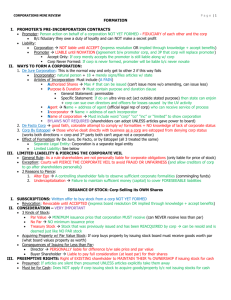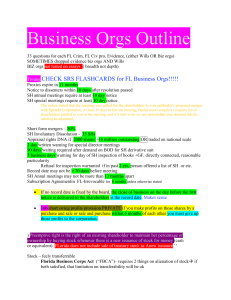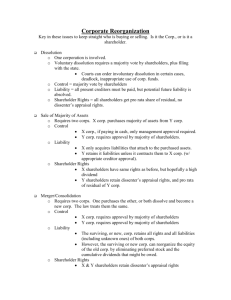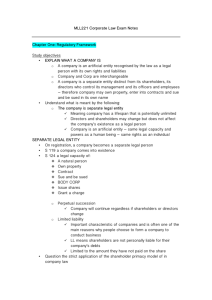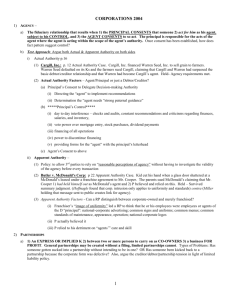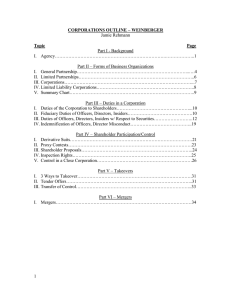Corporations - Law Office of Brendan Conley
advertisement
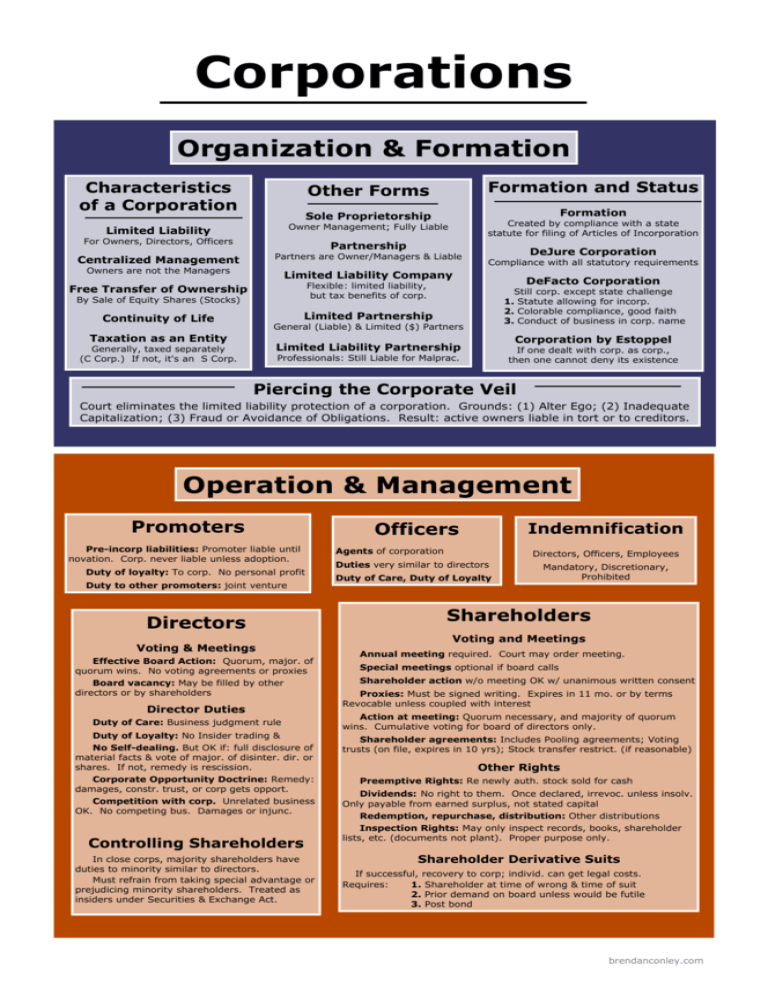
Corporations Organization & Formation Characteristics of a Corporation Formation and Status Other Forms Formation Sole Proprietorship Created by compliance with a state statute for filing of Articles of Incorporation Limited Liability Owner Management; Fully Liable Centralized Management Partners are Owner/Managers & Liable For Owners, Directors, Officers Partnership Owners are not the Managers DeJure Corporation Compliance with all statutory requirements Limited Liability Company DeFacto Corporation Flexible: limited liability, but tax benefits of corp. Free Transfer of Ownership By Sale of Equity Shares (Stocks) Still corp. except state challenge 1. Statute allowing for incorp. 2. Colorable compliance, good faith 3. Conduct of business in corp. name Limited Partnership Continuity of Life General (Liable) & Limited ($) Partners Taxation as an Entity Corporation by Estoppel Limited Liability Partnership Generally, taxed separately (C Corp.) If not, it's an S Corp. If one dealt with corp. as corp., then one cannot deny its existence Professionals: Still Liable for Malprac. Piercing the Corporate Veil Court eliminates the limited liability protection of a corporation. Grounds: (1) Alter Ego; (2) Inadequate Capitalization; (3) Fraud or Avoidance of Obligations. Result: active owners liable in tort or to creditors. Operation & Management Promoters Pre-incorp liabilities: Promoter liable until novation. Corp. never liable unless adoption. Duty of loyalty: To corp. No personal profit Duty to other promoters: joint venture Directors Voting & Meetings Effective Board Action: Quorum, major. of quorum wins. No voting agreements or proxies Board vacancy: May be filled by other directors or by shareholders Director Duties Duty of Care: Business judgment rule Duty of Loyalty: No Insider trading & No Self-dealing. But OK if: full disclosure of material facts & vote of major. of disinter. dir. or shares. If not, remedy is rescission. Corporate Opportunity Doctrine: Remedy: damages, constr. trust, or corp gets opport. Competition with corp. Unrelated business OK. No competing bus. Damages or injunc. Controlling Shareholders In close corps, majority shareholders have duties to minority similar to directors. Must refrain from taking special advantage or prejudicing minority shareholders. Treated as insiders under Securities & Exchange Act. Officers Indemnification Agents of corporation Directors, Officers, Employees Duties very similar to directors Duty of Care, Duty of Loyalty Mandatory, Discretionary, Prohibited Shareholders Voting and Meetings Annual meeting required. Court may order meeting. Special meetings optional if board calls Shareholder action w/o meeting OK w/ unanimous written consent Proxies: Must be signed writing. Expires in 11 mo. or by terms Revocable unless coupled with interest Action at meeting: Quorum necessary, and majority of quorum wins. Cumulative voting for board of directors only. Shareholder agreements: Includes Pooling agreements; Voting trusts (on file, expires in 10 yrs); Stock transfer restrict. (if reasonable) Other Rights Preemptive Rights: Re newly auth. stock sold for cash Dividends: No right to them. Once declared, irrevoc. unless insolv. Only payable from earned surplus, not stated capital Redemption, repurchase, distribution: Other distributions Inspection Rights: May only inspect records, books, shareholder lists, etc. (documents not plant). Proper purpose only. Shareholder Derivative Suits If successful, recovery to corp; individ. can get legal costs. Requires: 1. Shareholder at time of wrong & time of suit 2. Prior demand on board unless would be futile 3. Post bond brendanconley.com Capital Structure & Securities Regulation Capital Structure Fed: Rule 10b-5 of the Securities & Exchange Commission Debt Securities (Bonds) Arise when corporation has borrowed funds from investors and promises to repay them. Holders have no ownership interest. 1. Secured debt (Bonds) 2. Unsecured (Debenture) 1. Pay to holder (Bearer / Coupon) 2. Pay to reg. owner (Registered) Equity Securities (Stocks) Authorized Shares: Shares described in Articles of Incorp. Issued and Outstanding: Shares that have been sold Authorized but Unissued: Reacquired: buyback / redemption Classification: May have only one type of ownership interest (common stock) or classes or series with varying rights. Articles of Incorp must describe the classes & rights (E.g. “Class A Preferred”) Stock Subscriptions: Subscribers promise to buy corp. stock Par value: Set in Articles of Incorp. Very rare modernly. Watered stock: Sold less than par: directors liable for “water” Unpaid stock: Shareholder has not paid. Creditors may reach. Fed: Section 16(b) of the Securities & Exchange Act of 1934 Orig. insider trading provision, only for SEC Reporting Companies (On a nat'l exchange OR 500+ shares & $10 mil in assets) The general anti-fraud provision (1943) Applies to trade in ANY security 1. Standing: Plaintiff either bought / sold security based on fraud or omission, and suffered damages. 2. Jurisdiction: Federal case if defendant used means of interstate commerce or stock exchange 3. Materiality: The fact misstated or omitted one reasonable investor would attach importance to. 4. Scienter: Intentionally, knowingly, or with (extreme?) recklessness. Must plead w/ particularity 5. Reliance: (aka transaction causation) In fraud cases, plaintiff relied on misstatement in trading 6. Causation: (aka loss causation) The plaintiff must show that the fraud caused her damages. If plaintiff benefited from trade, no case. 7. Connection: “In connection with” the buying / selling of a security. Close in time. Rule 10b-5 & Insider Trading Fraud by omission: Insiders duty to “abstain or disclose” re. trading on inside information Reliance: Loss causation too hard to prove. Use reasonable investor or fraud on the market. Who's liable: Insiders, Tippers, Tippees, & Misappropriators Fed: Sarbanes-Oxley Act (2002) Short swing trading: Insiders (officer, director, or 10%+ shareholder) can't sell / purch., or purch. / sell corp's stock in 6 mo. Strict liability: Irrebutable presumption of misconduct. No fault New reporting requirements, civil and criminal penalties for accountants & lawyers aiding fraud “Terror damages”: Lowest price in, highest price out in 6 mo. Fundamental Changes in Structure General Procedure for Fundamental Changes: (1) Board adopts a resolution; (2) Written notice to shareholders; (3) Shareholders approve by majority of votes entitled to be cast; and (4) the changes in the form of the Articles of Incorporation are filed with the state. Merger Sale of Assets General Rule: Directors & shareholders of both corporations must approve, shareholders by majority of shares entitled to vote Short form merger does not require shareholder approval Director & Shareholder Approval Appraisal Rights of dissenting shareholder Requirements: 1. Written objection before meeting 2. Vote against merger or abstain 3. File written claim Amendment of Articles Corporation can amend articles. No appraisal rights. Bylaws Board of directors may amend or repeal bylaws unless articles exclusively reserve power to shareholders If sale, lease or exchange of substantially all corp. assets is outside the ordinary course of business, then requires approval of majority of directors and majority of shares entitled to vote De Facto Merger If sale of assets is de facto merger, triggers possible rescission or appraisal rights & purchasing corporation may be liable for debts & liabilities Dissolution & Liquidation Approval Needed Majority of directors and majority of shares entitled to vote must approve (no quorum concept) Creditors' Rights If liquidation, pay outside creditors first brendanconley.com






